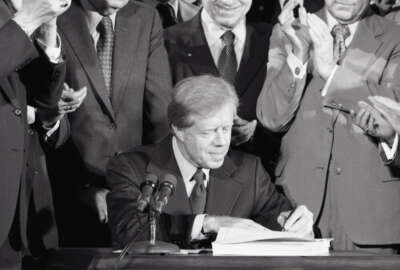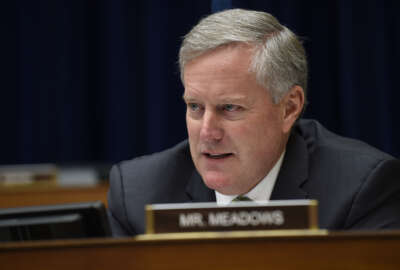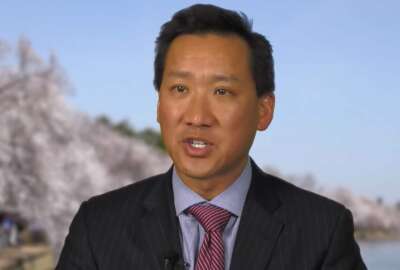
Bound by constraints of 40-year-old rules, civil service ready for a rebuild
Federal News Radio explores how an evolving federal workforce has been bound by the constraints of a 40-year-old civil service system that largely hasn't changed at...
To listen to the Federal Newscast on your phone or mobile device, subscribe on PodcastOne or Apple Podcasts. The best listening experience on desktop can be found using Chrome, Firefox or Safari.
Kristine Marcy never intended to make a career in government. But she met some life-changing mentors at a federal internship in 1967. She stayed, graduated law school and rose through the ranks of the General Schedule.
So when President Jimmy Carter signed the Civil Service Reform Act in 1978, which ultimately created the Senior Executive Service, Marcy jumped at the chance to shed her status as a “super grade” executive and join the SES.
“It was an easy transition, and I very much wanted that label of Senior Executive Service,” she said. “I saw myself as somebody who wanted to be stimulated, somebody who wanted to be challenged, somebody who liked change. I never wanted to get bored. I thought that this was an opportunity that I could move around the government [and] do interesting [and] challenging things.”
For Marcy, that’s exactly what the SES was. She took her management expertise to a total of 10 different agencies throughout her 34-year-federal career. She helped plan and advise leaders of two brand new agencies: the Department of Education and the Office of Personnel Management.
Marcy is like many of her fellow colleagues who joined the Senior Executive Service in the beginning. In interviews with Federal News Radio, about a half-dozen charter SES members described long and exciting careers filled with travel, high-level responsibility and some reward for their efforts.
But nearly all of them, including Marcy, described a general frustration with a few key hallmarks of the Senior Executive Service. Now the Trump administration says it sees those same frustrations with the SES and the decades-old system that created it.
“I’m not sure that the SES lived up to its potential,” Marcy said. “I think there may have been an initial assumption that the majority of senior executives would enjoy being reassigned or being challenged and asked to take on challenges outside their immediate agency.”
In envisioning the SES, the Carter administration said it wanted to create a mobile corps of executives, who were expected to periodically move and bring their expertise and management skills to a new position, often in another part of the country.
Dave Mader, who began his federal career as a part-time Postal Service employee in college and later climbed the ranks at the IRS, said he initially hesitated over the prospect of executive reassignments before joining the SES as a charter member.
But he ultimately accepted reassignments in different parts of New York, Newark, New Jersey, and Detroit, Michigan, before taking a job at the IRS headquarters in Washington. He retired there, later joining the Obama administration as controller at the Office of Management and Budget.
The moves were tough on his family, he said. His son at one point attended three different high schools in one year.
“In this day and age, it’s one of the biggest challenges with a two-professional career family,” Mader said. “How do you balance that? That’s a continuing, ongoing challenge that the Senior Executive positions present to people. But that mobility is also invaluable as well. I got to experience different offices, different environments, different cultures, and that all contributes to the growth of an executive over time.”
Mader, and several other charter SES members, said they saw their colleagues struggle to weigh the benefits that came with being a career senior executive and the impacts potential reassignments might have on their families.
The SES made sense for Marcy in 1978, she said, because she was young.
“Youth makes one more open to change,” she said. “I’m not sure that is true as people get older and they get more responsibilities, for example, for putting their kids through college.”
But today’s Senior Executive Service — and federal workforce — by all accounts isn’t young. Roughly 2 percent of today’s SES is under the age of 40, according to the most recent data from the Office of Personnel Management. At the same time, just more than 6 percent of the federal workforce is under the age of 30, with 1.2 percent of employees between the ages of 20 and 24. That means agencies generally lack a group of young, eager executives-in-training ready to take the reigns from the retirement-eligible baby boomers.
It’s these statistics that, in part, have kept federal managers up at night. They say they’re bound by the constraints of a 40-year-old civil service system that largely hasn’t changed at all since the disco era — despite a federal workforce that has.
As part of our special report, Civil Service Reimagined: 40 Years Later, Federal News Radio examined how past administrations and political appointees have largely passed up the chance to make those continual upgrades to the systems that manage their greatest asset: Their employees.
The original drafters of the Civil Service Reform say they built the foundation, the bedrock for a modern federal workforce, in 1978. It was up to subsequent administrations, cabinet leaders and federal managers to revisit the structure and occasionally touch up the paint to reflect new workforce realities.
“The Civil Service Reform Act has proven particularly resistant to incremental changes to deal with workforce realities,” said Paul Light, the Paulette Goddard professor of public service at New York University. “That’s the nature of big statutory reforms like that. You have to go back in every once in a while and tinker. Unfortunately, we’ve gotten ourselves into a situation where the only way to secure reform is to go back in with a sledge hammer and just rip up the entire thing — or threaten to rip up the entire thing in order to get flexibility.”
That’s what the Trump administration is attempting today. It’s a mammoth task, in search for a plan that will abandon a relic of the long-gone past and upend an entrenched workforce.
After all, the Civil Service Reform Act as the Carter administration said even in 1978, was about managing people.
And people change. The federal workforce certainly has. But the civil service system itself hasn’t yet shed its bell-bottoms and platform shoes for neat button-downs and patterned socks.
Today’s workforce is more educated, technical
Data from the Office of Personnel Management over the last 40 years shows a workforce that, though still largely bound by a static personnel system, has been susceptible to broader societal changes in education and technology.
When Congress passed the Civil Service Reform Act, baby boomers were entering the early or middle period of their careers, said Light, who has long studied the size and scope of the federal workforce.
Baby boomers in 1978 saw their government jobs as an outlet to advance steadily, do important work for the nation and retire in their early-to-mid-60s, Light said.
The civil service system of 40 years ago was designed more for secretaries, typists and clerks — not cybersecurity analysts or data scientists. Far more federal employees, nearly 389,000 of them, held clerical positions in 1978 compared to 2017, when about 81,000 workers held such jobs.
The blue collar federal workforce has been cut by more than half over the past 40 years.
The Office of Personnel Management only counted 136 unspecified feds in 2017.
Meanwhile, the federal government’s professional and administrative workforces, positions that typically require a bachelor’s degree or higher, have grown. Roughly 200,000 more employees in 2017 serve as grants or program managers, loan specialists or public affairs, for example.
As today’s work shifts away from blue collar, clerical positions, today’s federal employees have generally spent more time in school or other professional programs to learn more highly skilled material than their counterparts 40 years ago.
Far more federal employees hold a college or advanced degree in 2017 compared to 1978, according to OPM data.
In addition, government’s youngest employees today have different expectations of their federal jobs. Millennials, typically those employees born between in the early 1980s and early 2000s, are highly mobile and crave different opportunities throughout their career, Light said.
The built-in opportunities to move and accept new and different assignments within the Senior Executive Service sound tailor-made for the millennial generation.
But the SES wasn’t built for them. It was built for the baby boomer generation that was in the right place at the right time in 1978.
Agencies today have generally struggled to attract new, young members to the Senior Executive Service. The benefits of joining don’t often outweigh the risk, responsibility and stress of taking the job, said Carol Bonosaro, a charter SES member and former president of the Senior Executives Association.
“What’s gotten in the way is GS-15s looking at these jobs saying, ‘My gosh, unlike 20 years ago, you darn well have to be on call 24-7. You’re subject to being reassigned. There are still pay issues. Why do I want that? I’m not going to make enough more to put up with that?’ Bonosaro said. “That’s been a growing problem.”
Instead, federal managers have been left to find their own workarounds for a civil service that was created when tie-dye and the 8-track were in style.
“Part of what we have to struggle with is does the workforce have to fit the civil service or does the civil service have to fit the workforce?” Light said. “We do err on the side of making the workforce fit our system… and that’s why we have these continuing problems.”
The Office of Personnel Management typically records education levels at employees’ time of hire and updates such data only at an employee’s initiative.
Low morale, negative perceptions dominated
As the federal workforce has evolved over the past 40 years, there’s been little to no development in how agency leadership views and manages its own people.
Agencies largely say it’s the civil service system itself that prevents leaders from quickly hiring a new employee or firing a poor performer. Over the last 40 years, they’ve searched for quick fixes to whittle down the time-to-hire or asked for authority to remove employees more quickly.
Perhaps agencies have been looking in the wrong places.
The Carter administration said it never intended the Civil Service Reform Act to serve as the end of a conversation about the civil service. And none of the new SES flexibilities, whistleblower protections or other authorities that the act had created would make any difference without high-level leaders who valued and empowered the career workforce.
This was nuance even Carter acknowledged in signing the Civil Service Reform Act. The law “provides the tools; the will and determination must come from those who manage the government,” Carter said on Oct. 13, 1978 when he signed the bill into law.
But political appointees largely haven’t had the will and determination to find new, modern ways to empower and effectively manage their employees.
“[Political] leaders very rarely view one of their priorities as improving the health or the operational capability of the organizations they’re responsible for,” Max Stier, president and CEO of the Partnership for Public Service, said. “Part of this is caused by the fact that they’re short-term and these challenges require long-term investment, so you have this disconnect between short-term leaders and the long-term needs of the organizations they run.”
Many charter SES members described their frustrations working with a revolving door of political appointees, many of whom approached government with deep distrust of the people they were tasked to manage.
“The SES is not trusted, and by the time the guys that need to trust them figure out that they can, they’re gone,” said Ted Ankrum, a charter SES member who spent a long career at what eventually became the Energy Department, as well as NASA and the Nuclear Regulatory Commission. “The average political appointee lasts no more than two years, sometimes not even that long. By the time they figure out who it is that can help them, they’re gone.”
Former senior executives said many of the political appointees, both Democrats and Republicans, came to government with an entrenched bias about the career employees they were expected to work with. Federal employees were lazy and didn’t want to take risks, the appointees thought.
Even though the appointees’ perspectives of the federal workforce eventually tipped in a more positive direction, their initial attitude had already tainted the water.
“The public needs to understand that federal employees are among the victims of this suffocating bureaucratic system, not the cause,” Dwight Ink, executive director of Carter’s Personnel Management Project, told the Senate Governmental Affairs Subcommittee on Federal Services, Post Office and Civil Service in 1988. “We need to understand that within government, as we try to deal with these management issues, that systems and structures don’t manage. People do.”
Morale in the federal workforce was low in 1978, Ankrum and other charter SES members said. But it seems worse today, many observed.
“No organization gets better if all you do is kick it, and that’s the experience of most federal employees,” Stier said.
But Bonosaro, the longtime Senior Executives Association president, and Mader, the former Obama appointee who first served as a career executive, both pointed to bright spots in their federal careers when a political leader set the right tone with its top career leaders.
Flanked by his cabinet secretaries on stage, former President George H.W. Bush addressed the SES cohort at the very beginning of his presidency. Former President George W. Bush also addressed the SES twice during his time in office.
“He sent a message. ‘We’re on the same team, and we’re going to work together and that’s what I expect of my appointees,'” Bonosaro said of George H.W. Bush’s speech in 1989. “The people who walked out of there would have walked on water for him. That set the right tone. If you set the right tone and keep sending the message, it’s not that hard. But it has to be there from the beginning.”
But tone isn’t something Congress can legislate.
The Carter administration acknowledged it then in 1978, and it was concern for the civil service reform creators who looked back at the Civil Service Reform Act even just 10 years after its passage.
“We believed the most significant change that could be made was, and is today, that of the appointment of agency leadership, an OPM leadership with managerial experience which enables them to understand the value of a merit system, the importance of positive personnel incentives and the high cost to our taxpayers of the many disincentives which confront the federal workforce,” said Ink, Carter’s Personnel Management Project director. “We concluded that without a fundamental change in this negative approach to the federal workforce, no amount of legislation, no amount of procedures and no amount of reorganization would make much difference.”
Copyright © 2025 Federal News Network. All rights reserved. This website is not intended for users located within the European Economic Area.
Nicole Ogrysko is a reporter for Federal News Network focusing on the federal workforce and federal pay and benefits.
Follow @nogryskoWFED






